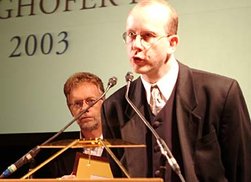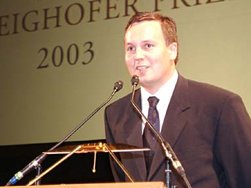Winners 2003
Main Prize
Development of fully automated joinery machines
In former times the joining of wooden beams was only made possible by labour-intensive manual work, where the constructors had to cope with inaccuracy. Due to this, sheet metal joints were developed, which served well but were not satisfactory for every purpose. The Main Prize winner, Hans Hundegger, invented and further developed fully automated, high performance computer numerical control (CNC) joinery machines and matching software. These joinery machines enable easy design and construction of completely individual solid-wood assemblies. Marking, processing and labelling are carried out automatically to make anything from simple beams to complex assemblies. Additionally Hans Hundegger has developed several other machines, like planers or panel cutters. Hans Hundegger sets high standards for his machines and puts emphasis on constant improvement. The main goals are still the same - easy handling and perfect performance even under difficult conditions. The success is undeniable – 1,700 machines have been sold worldwide, and he is world market leader for joinery machines. Besides his outstanding performance and career, Mr. Hundegger also shows a very social philosophy - he will donate parts of his prize money of 150,000 EURO to charity organisations. Additionally he will invest a part of the money for further research and development of some new and innovative ideas in the field of wood construction. Mr. Hundegger is a worthy winner of the first Main Prize 2003.
Hans Hundegger, born 1954 in Germany, started his career in 1972 with an apprenticeship in techni-cal drawing at the Otto Martin Company, where he continued working as a design engineer. In addition, he completed his training as mechanical engineer. In 1979 he founded his own company, the Hans Hundegger Mechanical Engineering Company in Hawangen, Germany, which at present employs a staff of 145. The company has branch offices and partner companies in Switzerland, France, Finland, Italy, USA and Japan.
Contact: info@hundegger.de / www.hundegger.de
Supporting Prize Category Timber Products, Wood Utilisation, Forest Products Marketing
Due to the outstanding quality and quantity of submitted works in this category, the prize has been divided between 2 entries.
Supporting Prize Category Timber Products, Wood Utilisation, Forest Products Marketing
1) A new biological wood based panel made of sawdust and wood flour
At least 200 million cubic meters of sawdust and wood flour are produced every year by wood proc-essing. Due to their low fibre quality, those materials have up to now, normally been used as fuel by the wood working industry. The inventor Christoph Affentranger, supported by his investor Otto Hofstetter, both from Switzerland, had the idea of producing a wood based material made of the above side products using a very old technology similar to that used in baking bread. Sawdust and wood flour are mixed with biological additives, micro-organisms and yeast. Using a biotechnological method this mixture gets fermented into a kind of wood paste, which is then dried. The material even looks like dried bread, and is very porous and stiff. In relation to its low density and weight, the resulting panel has good strength properties. It can be processed like solid wood, for example by sawing, drilling, sanding, gluing or shaping. As the material is free of glue or other non-biological substances it is biodegradable. The material is called SLP or iwood-panel. The winners are heading towards opening a first industrial production plant in 2005. This wood-based material is completely new and very innovative. Furthermore, it contributes to an increased added value within the woodworking industry under sustainable conditions. Therefore it is worthy of a Schweighofer Prize.
Christoph Affentranger was born in 1965 and studied architecture at the Swiss Federal Institute of Technology (ETH) in Zurich. Until 2001 he worked as an independent architect and journalist. Otto Hofstetter, born in 1953, is a businessman with special experience in investment; he also founded several companies, for instance Rotex Helicopter AG. In 2001 Christoph Affentranger and Otto Hof-stetter together founded the innovation wood company (i-wood); its headquarters is located in Baar, Switzerland.
Contact: info@iwood.ch / www.iwood.ch
Supporting Prize Category Timber Products, Wood Utilisation, Forest Products Marketing
2) Innovative, material-efficient, prefabricated wall- and-roof system - CELLTEC
Innovative, material-efficient, prefabricated wall-and-roof system – CELLTEC: Prefabricated wood elements for dwelling houses have become quite common and can be found on the market in various designs. This contrasts with industrial buildings with large spans, where especially the market for secondary roof elements is still dominated by steel construction, mainly due to their low costs and lean designs. Michael Stache from Germany took up the challenge to develop a new wall-and-roof system in order to enter a new market segment of industrial buildings. He received the second prize in this category for his development of a material-efficient, prefabricated wall-and-roof system. The so-called CELLTEC-element is made of oriented strand boards (OSB) and thin particle boards. Its honeycomb structure imitates the structure of a hardwood vessel in order to reach all natural advantages of wood such as light weight, high strength, easy processing and excellent insulation properties. This special design realises lean and twist-free wood constructions. Later on it should also be used for dwelling houses. CELLTEC provides the wood industry with a new market for wall and roof elements for large spans typical of industrial constructions. This is a vital step towards increasing the use of wood in Europe; therefore it is awarded the Schweighofer Prize.
Michael Stache, born 1967 in Germany, took an apprenticeship as a joiner and studied at the University of Applied Sciences in Rosenheim (Wood Technology). Since 1995 he is head of the R&D department of the Austrian Wiesner-Hager Baugruppe Holding GmbH in Altheim (Upper Austria). Since 2001 he has been teaching at the University of Arts and Industrial Design in Linz (Upper Austria).
Contact: m.stache@wiehag.com / www.wiehag.com
Supporting Prize Category Wood Technology
New technology for fire-retardant treatment of wood
Fire regulations are one of the biggest obstacles for the increased use of wood in multi-storey buildings. Up to now wood has been treated with fire-retardant salts, which have several disadvantages. They are hygroscopic and water soluble, therefore not usable under humid or even weathered conditions. Additionally, the chemicals are toxic and treated wood had to be disposed of as hazardous waste. The Norwegian Lars Grotta has developed both a new method for impregnation and an innovative combination of chemicals in order to fix the fire-retardant substance to the wood. The special mixture of salts and monomers allows liquid impregnation using a newly developed vacuum-pressure method. This process is even usable for spruce, which is hardly impregnable due to its special wood anatomy. After the impregnation process the treated wood is kiln-dried. During the drying process the substance is fixed to the wood. This innovative method results in wood that meets the demands of the relevant European standards (Euroclass B). It is non-corrosive, the impregnation is waterproof and the treated wood is biologically safe. Because of this development the use of wood can be increased sustainably both inside and outside in multi-storey buildings (e.g. claddings) or even off-shore. Lars Grotta has met the conditions of the Schweighofer prize to the fullest extent.
Lars Grotta was born in Norway in 1969. From 1990 to 1995 he studied at the Norwegian Agricultural University (Forestry and Wood Technology). Since 1995 he was responsible for R&D at the Moelven Fire Guard AS Company, recently he changed within the group to Moelven Mjøsbruket AS where he is working as sales manager.
Contact: lars.grotta@moelven.com / www.moelven.com
Supporting Prize Category Forestry
Establishment of a research fund in favour of the Ukrainian State University of Forestry and Wood Technology in Lviv
Due to the fact that only a few applications were received in the Category ‘Forestry’, and they did not exhibit the same quality and standard as the other categories, the jury took the decision not to awarding the prize this year. The prize amount of 50,000 EURO was instead used according to the conditions of the Schweighofer Prize. Both Mr. Gerald Schweighofer and the jury decided to establish a fund in order to support a research institution which is not sufficiently equipped to carry out high quality research work. The support of research and economy in Eastern European countries is one of Mr. Schweighofer's favourite goals. Therefore the Ukrainian State University for Forestry and Wood Technology in Lviv was selected to be the beneficiary of the fund. It was founded in 1874 in Lviv, where it was established as an Institute of Forestry. After 1945 it was re-organised as a Forestry College with already several institutes. Since 1993 the University has been divided into four faculties. One of those is the Faculty of Forestry which contains seven departments and employs 13 professors, 34 associated professors and 15 research assistants. The fund will help financing projects and equipment for young researchers in order to provide them the possibility to reach a European standard in research and development.





